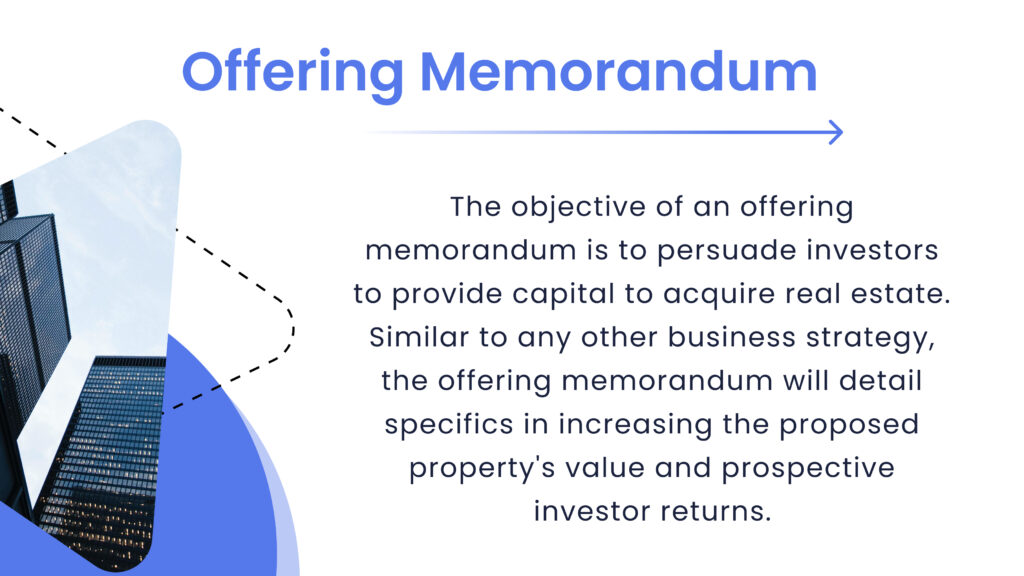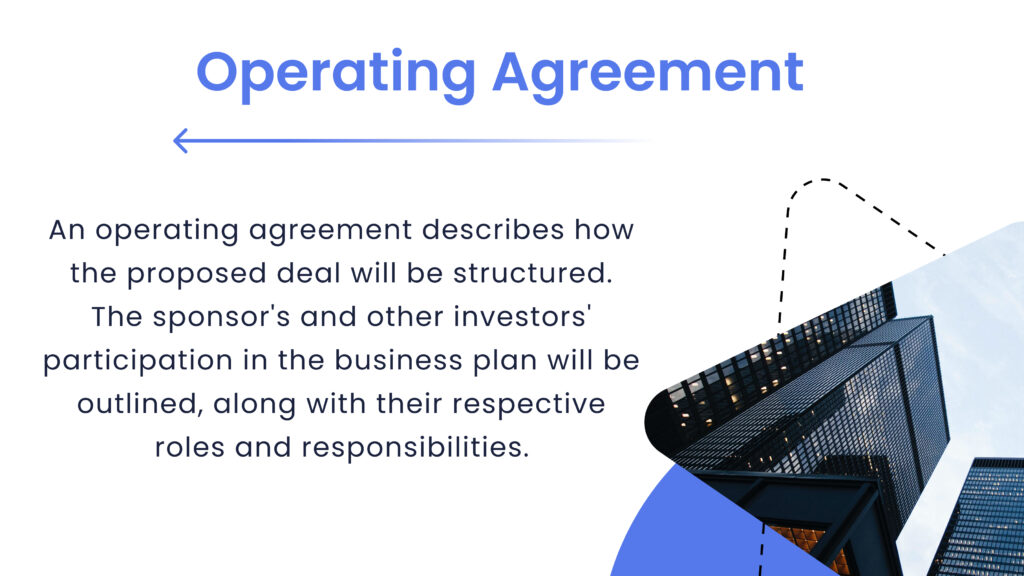A commercial real estate offering memorandum (OM), also known as an investment memorandum or a private placement memorandum (PPM), is a tool used to introduce prospective buyers or investors to the property and is vital in presenting your sale opportunity, credibility, and professionalism.
Offering memorandums are often used in apartment syndications and in various types of commercial real estate investments. While marketing flyers and brochures are sent publicly to an investing community at large, a smart commercial real estate OM is used to stimulate interest among the most qualified potential investors and bring them to the negotiating table.
In essence, an offering memorandum is simply a collection of terms that describes in detail the property and examines specifics in expenses, duties, and returns at every phase of the investment process before finalizing and binding both parties.
In this article, we’ll examine what an investment offering memorandum is in commercial real estate, how it’s utilized, and briefly how to build one.
What is an Offering Memorandum?
A real estate offering memorandum is a legal document that informs investors about the property and the offering, safeguards the sponsor from potential liabilities, and acts as a means of reducing the number of investors.
The objective of an offering memorandum is to persuade investors to provide capital to acquire real estate. Similar to any other business strategy, the offering memorandum will detail specifics in increasing the proposed property’s value and prospective investor returns.
The offering memorandum defines the investment’s goals and risks, as well as the terms and conditions of the commercial real estate private placement. The contents of an offering memorandum include the following:
- Description of the property, including an overview of the site, location, demographics, operation, and management.
- A summary of the property’s historical, current, and projected future returns based on various assumptions
- The Pro-forma financial statements, a profit and loss statement, a balance sheet, and an investor distribution schedule.
- Biographies of the management and investment companies
- Confidentiality agreement and participation criteria

Why is an Offering Memorandum Necessary?
Many real estate deals are complicated in nature and include numerous risks and profit opportunities. An offering memorandum sets the tone for how the transaction will proceed and addresses any probabilities prior to agreement.
In addition to setting the foundation, an offering memorandum provides investors with a thorough business plan and overview of the investment to use as part of their due diligence. OM’s should be written clearly and concisely, outlining the management fees, investors’ voting rights, the indebtedness of the business, and the manner in which the investment will be repaid.
Sections included in a Real Estate Offering Memorandum
Offering memorandums vary based on the investment type. When putting your OM together, make sure the document includes the following:
Introduction:
The introduction should cover a summary of the investment opportunity, a description of the property, the minimum amount of cash necessary to invest, the expiration date of the offer, and a list of all risks involved in the investment.
Disclosures:
There are three types of disclosures in a real estate offering memorandum:
- Sponsor Disclosure – The sponsor disclosure provides proof that the sponsor is capable of entering the deal and will contain the sponsor’s general and contact information, as well as a summary of all fees and earnings owed to the sponsor. The disclosure will also provide background information on the sponsor, including their deal history.
- Property Disclosure -The property disclosure contains detailed information about the property, including the estimated cost and revenue metrics. The property disclosure should also contain the issuers’ intentions for the capital raised in the private placement deal.
- Risk Disclosure – Any risks that the investor should be aware of will be outlined in the risk disclosure. For example, some risks may include environmental problems or potential market issues.
Operating Agreement:
The operating agreement describes how the proposed deal will be structured. The sponsor’s and other investors’ participation in the business plan will be outlined, along with their respective roles and responsibilities. Additionally, it should explain each party’s rights and obligations, including their amount of ownership, termination schedule, and ownership transfer procedures.

Investment Summary:
The investment summary covers various subtopics within an offering memorandum that include the following:
- Property description
- Investment opportunity
- Purchase price
- Total capitalization
- Preferred returns
- Manager/Sponsor
- Property/Asset manager
- Proposed structure
For more elaboration on real estate terms, check out this article.
Subscription Agreement:
The subscription agreement is a replica of the contract that would be signed by the investor if they decide to go through with the deal. It should outline the conditions and the percentage of ownership that an investor would be granted.
How to Put Together an Offering Memorandum
Typically, an investment banker that the firm has engaged would create the offering memorandum template. A good investment memorandum should emphasize your company’s merits and give investors all the relevant data they need to fulfill their due diligence.
When putting together your offering memorandum, consider the following:
- Business Plan: The business plan will showcase how you intend to run the property, cost and revenue projections, and marketing strategies. It should also include a timeline for when you expect to close on the property and when you can start collecting rent.
- Commercial Real Estate Offering Plan: An explanation of your business and its objective should be included in your commercial real estate offering strategy, as well as a financial prediction of the property’s worth and income projection for the property.
- References: Include a list of references from previous or current clients who can attest to your business’s reputation and capacity for effective project execution.
Additional details to include would be the executive summary, sections on risks and disclosures, information on the deal’s structure, and a form to determine the eligibility of investors. You also want to outline the investor(s) down payment, interest rate, annual percentage rate, and any additional fees, such as closing expenses.
Conclusion
An offering memorandum is essential for investing in commercial real estate and gives a concrete outline of the critical information regarding the property seeking to be acquired. By including an offering memorandum in your real estate deal will help streamline the transactional experience for both the sponsor and investors and acts as a legal document to maintain accountability throughout the property’s holding period.
If you’re a sponsor, having the right knowledge base coupled with a solid investment management tool can help you get the most out of raising capital for your next real estate venture and allows you to draw in the ideal investors and speed up the entire syndication process.
InvestNext can help you manage the entire life cycle of your real estate syndication deal. Our full-service investment management software allows you to efficiently oversee all aspects of your capital raise in one place. From same-day ACH transactions to waterfall calculations, impress your investors with stylish deal rooms and a clean-cut easy-to-use investor portal.
Schedule a demo today to see how our team can help you to welcome the next level of raising capital.



